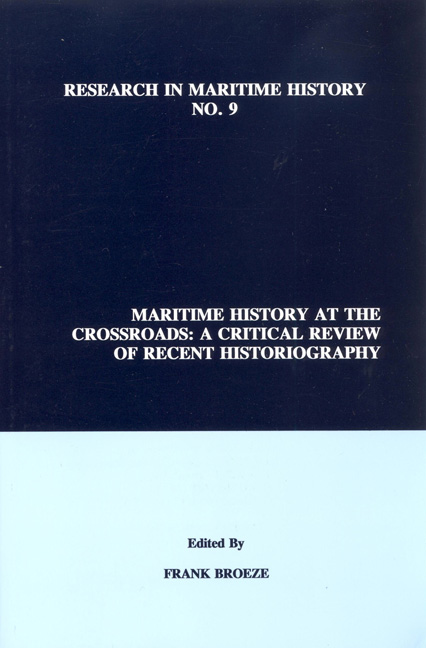Book contents
- Frontmatter
- Contents
- About the Editor
- Introduction
- Contributors
- “Maritime History in Australia”
- “The Enterprising Canadians: An Assessment of Canadian Maritime History since 1975”
- “The Historiography of Maritime China since c. 1975”
- “Danish Maritime History, 1976-1992: A Review”
- “German Maritime Historical Research since 1970: A Critical Survey”
- “The Maritime Historiography of Greece in Recent Decades”
- “Ibero-American Maritime History: Recent Advances in Research, 1975-1994”
- “Indian Maritime Historiography: West Coast Merchants in a Globalizing Economy”
- “Recent Developments in the Historiography of Maritime History in the Netherlands”
- “The Ottoman Empire: Recent Research on Shipping and Shipbuilding in the Sixteenth to Nineteenth Centuries”
- “The Progress of Maritime History in Spain since 1975”
- “Oceanic Historiography: The American Dimension”
“The Ottoman Empire: Recent Research on Shipping and Shipbuilding in the Sixteenth to Nineteenth Centuries”
from Contributors
- Frontmatter
- Contents
- About the Editor
- Introduction
- Contributors
- “Maritime History in Australia”
- “The Enterprising Canadians: An Assessment of Canadian Maritime History since 1975”
- “The Historiography of Maritime China since c. 1975”
- “Danish Maritime History, 1976-1992: A Review”
- “German Maritime Historical Research since 1970: A Critical Survey”
- “The Maritime Historiography of Greece in Recent Decades”
- “Ibero-American Maritime History: Recent Advances in Research, 1975-1994”
- “Indian Maritime Historiography: West Coast Merchants in a Globalizing Economy”
- “Recent Developments in the Historiography of Maritime History in the Netherlands”
- “The Ottoman Empire: Recent Research on Shipping and Shipbuilding in the Sixteenth to Nineteenth Centuries”
- “The Progress of Maritime History in Spain since 1975”
- “Oceanic Historiography: The American Dimension”
Summary
The Seven Seas
When the Ottoman Empire reached the zenith of its power at the end of the sixteenth century, it was surrounded by seven seas. Starting from the north, it had near absolute control over the Black Sea and the Sea of Marmara. The Aegean, eastern Mediterranean and Red Seas were effectively controlled despite occasional challenges, while the Persian Gulf and the Indian Ocean were zones of conflict in which Ottoman influence was apparent.
This sequence from the Black Sea to the Indian Ocean also reveals the level of our knowledge of Ottoman maritime history; while we are best informed about the Black Sea, our understanding of Ottoman affairs in the Indian Ocean is relatively vague. This may well reflect the fact that the Black Sea was a jealously-guarded “Ottoman Lake” and all foreign shipping was strictly controlled and meticulously recorded. These records are available in the Finance Ministry Registers in the Turkish Prime Ministry Archives and constitute a primary source for historians.
There were many reasons why the Ottomans attached such importance to their monopoly over the Black Sea. First, it was a region that supplied wheat and white slaves, both strategic commodities. The former constituted one of the pillars of Ottoman economic doctrine, provisionism (the policy of supplying big cities with foodstuffs and state-run enterprises with raw materials; Genç, 1990), while the latter had important implications for Ottomans’ relations with Egypt. Second, from a military perspective, the Black Sea had to be carefully controlled since it provided security on the north and allowed the Ottomans to concentrate on their remaining borders.
By the end of the sixteenth century the Black Sea was totally under Ottoman rule. But the first Turkish pirates were seen in the region as early as the 1360s (Makris, 1988, 265) and Halil Inalcik has shown that by the 1490s Ottoman merchants already dominated Black Sea trade (Inalcik, 1973, 129-130). The closure of the Black Sea had an important impact on existing trade routes. The Ottomans consciously rerouted trade and made Istanbul the entrepôt of the Black Sea. The ancient silk road, which until the end of the fourteenth century reached Trabzon before crossing the sea and continuing via the Crimea to the west and northwest, was rerouted to cross Anatolia, with Istanbul, Bursa and later Izmir becoming the major termini.
- Type
- Chapter
- Information
- Maritime History at the CrossroadsA Critical Review of Recent Historiography, pp. 213 - 228Publisher: Liverpool University PressPrint publication year: 1995



